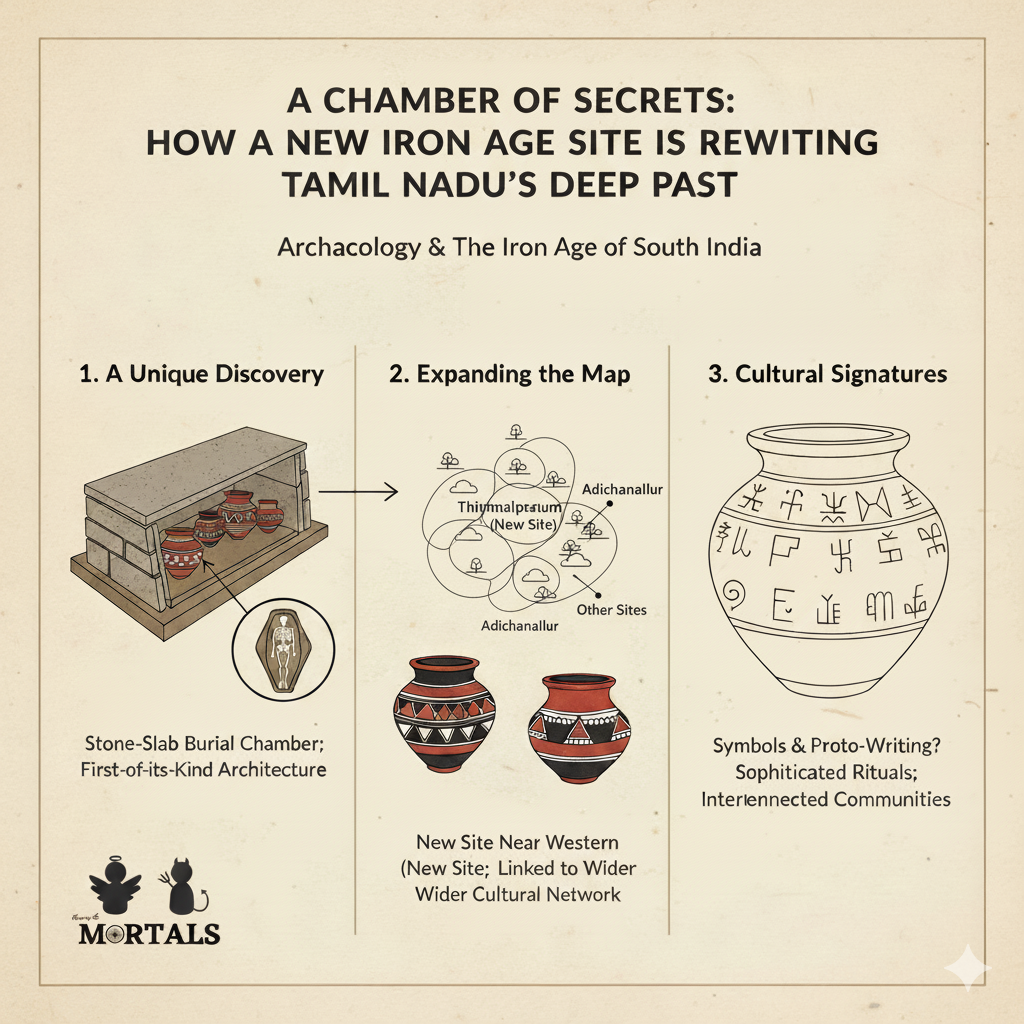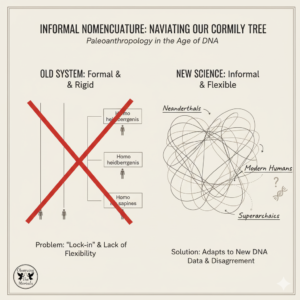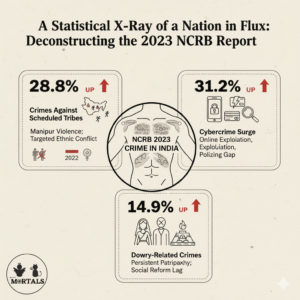The Western Ghats of Tamil Nadu have long been known for their breathtaking natural beauty. But beneath the soil, another, much older story has been waiting to be told. Recent excavations by the Tamil Nadu State Department of Archaeology at Thirumalapuram have unearthed a spectacular Iron Age burial site, revealing a culture with sophisticated rituals and surprising artistic connections. The centerpiece of the discovery—a unique, stone-slab burial chamber—is being hailed as a first-of-its-kind find, adding a crucial new chapter to the ancient history of Tamil civilization.
The Information Box
Syllabus Connection:
- Paper 2: Chapter 1.1 (Indian Prehistory: Iron Age, Megalithic Cultures)
- Paper 1: Chapter 1.3 (Archaeological Anthropology), Chapter 1.8 (Cultural Evolution: Iron Age)
- GS-1: Indian Heritage and Culture, Ancient History
Key Concepts/Tags:
- Iron Age, Tamil Nadu Archaeology, Urn Burials, Black-and-Red Ware, Megalithic Culture, Thirumalapuram, TNSDA
The Setting: Who, What, Where?
The setting is the newly excavated archaeological site of Thirumalapuram in the Tenkasi district of Tamil Nadu, located near the foothills of the Western Ghats. The work is being carried out by the Tamil Nadu State Department of Archaeology (TNSDA). The site is a massive 35-acre burial ground from the Iron Age. The key discoveries include numerous urn burials, a rich collection of ceramics, and, most importantly, a unique burial chamber.
The Core Argument: Why This Study Matters
This is not just another discovery; it adds significant new layers to our understanding of the Iron Age in South India.
- A “First-of-its-Kind” Burial Architecture: The most significant discovery is a large, rectangular chamber built from 35 stone slabs, which itself contained multiple burial urns. This is a major architectural finding, suggesting a more complex and labor-intensive mortuary practice than a simple urn burial. It points to a society with sophisticated ritual beliefs and the organizational capacity to construct such elaborate structures for their dead.
- Expanding the Map of Iron Age Culture: The location of the site near the Western Ghats extends the known geographical spread of this particular cultural complex in ancient Tamil Nadu. It demonstrates that these Iron Age communities were not just confined to the river plains but had established significant settlements and cultural centers in the hill regions as well.
- Confirming a “Cultural Signature”: The discovery of black-and-red ware pottery with distinctive white-painted designs is a crucial piece of evidence. This specific artistic style is a “cultural signature” that has been found at other major Iron Age sites in Tamil Nadu, such as Adichanallur and Sivagalai. This confirms that the people of Thirumalapuram were not an isolated group but were part of a wider, interconnected cultural network that shared common artistic and technological traditions across the region.
The Anthropologist’s Gaze: A Critical Perspective
- Beyond the Artifacts: Inferring Social Structure: An anthropologist would look beyond the objects to infer the social organization of the people who created them. A large, complex burial site with elaborate structures like the stone chamber suggests a settled, surplus-producing society. The presence of grave goods and the variation in burial types (some in a grand chamber, others not) could be an indicator of social stratification—that some individuals or families were accorded higher status in death than others.
- The Symbols and the Script: The report highlights the “striking discoveries” of symbols on the urns. This is a critical area for analysis. Are these symbols merely decorative, or are they a form of proto-writing? This finding feeds directly into the larger, ongoing academic debate in South India about the origins of the Tamil-Brahmi script and the presence of a pre-literate symbolic communication system during the Iron Age.
- The Power of Regional Archaeology: It is significant that this excavation is being led by the Tamil Nadu State Department of Archaeology (TNSDA), not the central ASI. This is part of a broader, important trend where state-level archaeological bodies are actively and scientifically exploring their own regional histories. These state-led projects are often crucial in uncovering a more detailed, nuanced, and locally specific picture of the past, adding immense richness to the broader narrative of Indian history.
The Exam Angle: How to Use This in Your Mains Answer
- Types of Questions Where It can be Used:
- “Discuss the salient features of the megalithic/Iron Age cultures of South India.”
- “How are new archaeological findings changing our understanding of ancient Indian history?”
- GS-1 (Heritage): “Discuss the major archaeological sites and their importance in understanding the history of Tamil Nadu.”
- Model Integration:
- On the Iron Age in Tamil Nadu (Paper 2): “The Iron Age in Tamil Nadu is characterized by practices like urn burials and the use of Black-and-Red ware. Recent excavations at Thirumalapuram in Tenkasi have added a new dimension, revealing a ‘first-of-its-kind’ stone slab chamber containing multiple urns, indicating a more complex burial architecture than previously known.”
- On New Discoveries: “Ongoing excavations continue to refine our understanding of prehistory. The discovery of white-painted pottery at Thirumalapuram, for instance, confirms its cultural link to other major Tamil Nadu sites like Adichanallur, reinforcing the idea of a widespread, interconnected cultural network during the Iron Age.”
- For a GS-1 Answer: “New archaeological sites are crucial for understanding the depth of India’s ancient past. The recent discovery of an Iron Age burial site at Thirumalapuram in Tamil Nadu, with its unique stone chamber and artifacts, provides a vital link to other famous sites like Adichanallur and enriches the cultural history of the region.”
Observer’s Take
The discovery at Thirumalapuram is a powerful reminder that history is not a closed book; it is a living story that is constantly being unearthed from beneath our feet. This is not just about finding old pots and graves. It is about piecing together the social, cultural, and spiritual world of the earliest settled communities of the Tamil land. Each new site, like Thirumalapuram, adds a crucial piece to the puzzle, pushing back the frontiers of our knowledge and revealing a past that is far more complex, interconnected, and sophisticated than we ever imagined. It is a testament to the power of archaeology to give a voice to the ancestors who left their stories written not in texts, but in stone and clay.
Source
- Title: Recent digs in T.N.’s Tenkasi reveal presence of Iron Age culture
- Author: N. Sai Charan
- Publication: The Hindu





